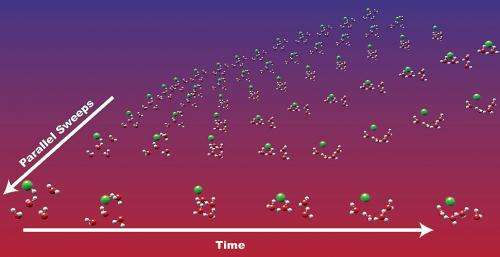Parallel in time algorithms enable simulation of long-lasting chemical processes

(Phys.org) —Molecular dynamics simulations often require too much time to be practical for simulating important chemical processes that take place on long timescales. Using EMSL-developed NWChem, researchers provided evidence that time integration algorithms working in parallel can significantly speed up computationally demanding molecular dynamics simulations, opening new avenues for studying complex, long-lasting chemical processes.
New parallel in time algorithms that speed up high-level molecular dynamics simulations can enable scientists to predict the properties of complex materials. They are designed to use NWChem and other molecular simulation programs. This research is important for toxic waste disposal, nuclear waste storage, carbon sequestration, energy storage, drug discovery, disease treatment, efficient catalysis, the optimization of electronic device performance, and other applications relevant to addressing the nation's major energy and environmental problems.
Molecular dynamics simulations provide valuable information about the physical movements and interactions of atoms and molecules over time. Unlike classical approaches, ab initio molecular dynamics (AIMD) simulations provide accurate calculations of the movements of electrons, enabling scientists to study chemical reactions that involve the breaking or formation of covalent bonds. Although AIMD simulations are useful for a wide range of important problems in areas such as liquid structure, acid–base chemistry, industrial and biological catalysis, atmospheric and aerosol chemistry, geochemistry, nanotechnology, and materials science, their use is limited because they are very computationally costly.
More time-efficient simulations have been made possible by massively parallel supercomputers and parallel algorithms, which distribute the computational workload across different processors or computers. Still, AIMD approaches currently take several months to simulate events that span picoseconds, even though many important chemical processes take much longer.
To address this problem, researchers from EMSL and the University of Chicago tested several parallel algorithms that distribute computations for different time intervals of a chemical event to different processors. These parallel-in-time algorithms sped up a conventional molecular dynamics simulation of 1,000 silicon atoms by a factor of three, and a challenging AIMD simulation of an atmospherically important chemical reaction involving hydrochloric acid by a factor of 14. When the AIMD simulation of this chemical process was performed on the massively parallel Chinook computer at EMSL, the Environmental Molecular Sciences Laboratory, a DOE national scientific user facility, the use of parallel in time algorithms compared with sequential algorithms reduced the duration of each computational time step from 32 seconds to seven seconds.
The parallel-in-time algorithms are suitable for cloud computing—running the programs using a large number of computers connected through a real-time communication network such as the Internet. The speedup provided by these algorithms occurred even when they were implemented on machines connected by very slow networks such as WiFi or in different time zones connected by the Internet. Moreover, these algorithms can be implemented using scripting languages such as Python as well as standard quantum chemistry packages, such as NWChem—an open-source computational chemistry code developed at EMSL. Taken together, the findings demonstrate that parallel-in-time algorithms can allow researchers to use powerful AIMD simulations to study realistic and complex chemical processes that take place on long timescales.
More information: Bylaska, E.J., Weare, J.Q., and Weare, J.H. "Extending molecular simulation timescales: Parallel in time integrations for high-level quantum chemistry and complex force representations." J Chem Phys. 139(7):074114 (2013). [DOI: 10.1063/1.4818328].
Provided by Environmental Molecular Sciences Laboratory



















